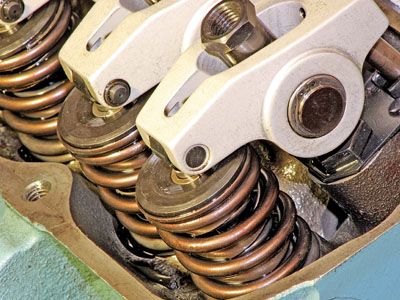
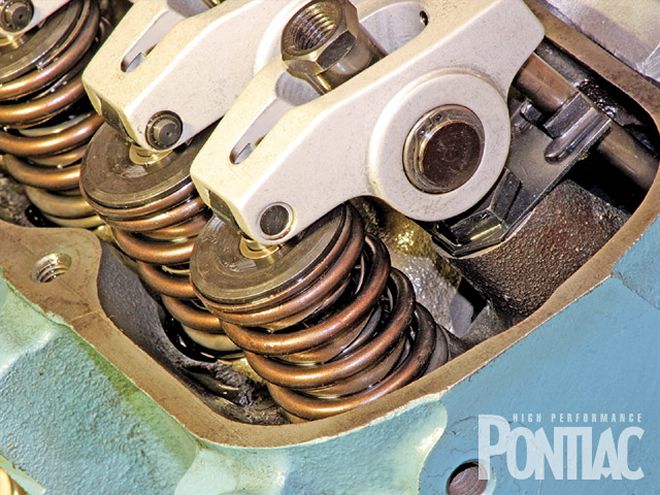
An engine's valvesprings play a critical role in its performance, yet those incorrectly chosen for a given application can cause hobbyists to unknowingly point blame in another direction if an engine doesn't live up to its full potential. While it seems that many are familiar with valvespring basics, you may be surprised to learn that they are among the most highly stressed components of the entire engine assembly-and the most misunderstood.
Like all other facets of the hobby, valvespring technology is rapidly changing. Not only are the materials and manufacturing processes continually improving, but cylindrical multispring packages are being replaced by uniquely shaped single-spring units in myriad applications. Comp Cams in Memphis, Tennessee, is one company that's at the forefront of that technology, and we contacted Comp engineer Thomas Griffin for his insights. Here's what he shared with us.
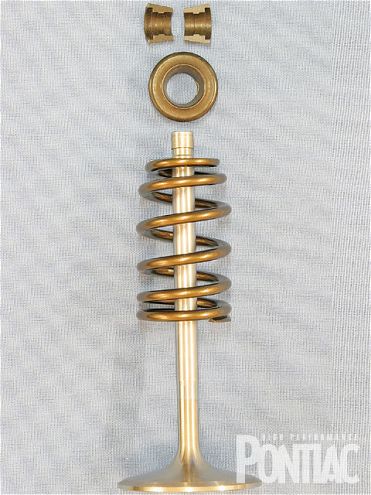 The load placed on the valvespring increases the higher an engine operates. When designing or selecting them for a given combination, valvetrain engineers must consider all of the components being employed. Overall valvetrain weight includes the valve, valvespring, retainer, and lock, and can oftentimes dictate an engine's maximum speed.
The load placed on the valvespring increases the higher an engine operates. When designing or selecting them for a given combination, valvetrain engineers must consider all of the components being employed. Overall valvetrain weight includes the valve, valvespring, retainer, and lock, and can oftentimes dictate an engine's maximum speed.
High Performance Pontiac: What is your present position with Comp Cams, and how long have you been with the company?
Thomas Griffin: I've been with Comp Cams for 16 years and am now a senior project engineer. I began my career building the static and dynamic testing lab for valvetrain components, and I acquired a wealth of hands-on experience as a test engineer dealing with valvetrains. That includes those engines found in street cars, sportsman class racing, NHRA Pro-Series, and most types of NASCAR racing. I progressed into component and system design; my primary functions now are valvespring design and project management.
HPP: In simplest terms, what is the purpose of a valvespring?
TG: Its function is to control valve motion while the camshaft forces the valve open and to keep the valve closed between valve events, but it must also dampen the resonant harmonics it generates during that action.
HPP: What materials are used to produce valvesprings?
TG: The stresses that valvesprings endure continually escalate with the constant push to run faster, and that typically means increased engine speed and valve lift. The materials from which they're constructed are becoming increasingly stronger, and the processes are making the pieces last longer under harsher conditions.
The most widely used materials employed today are super-clean chrome silicon alloys. Chrome silicon (CS) is the base alloy, and several alloying elements are added to enhance properties such as fatigue life and tensile strength. Material scientists are constantly experimenting with different alloying agents in an attempt to improve upon them.
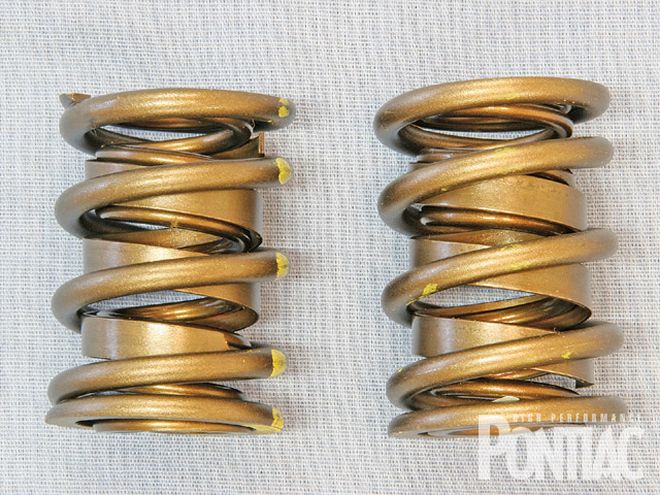 Traditional dual-valvesprings such as these were commonplace on vintage Pontiac engines. Remaining quite popular today, technology has brought us new advances that improve effectiveness and even allow the use of dual-spring packages where high-pressure, triple-spring packages were once required.
Traditional dual-valvesprings such as these were commonplace on vintage Pontiac engines. Remaining quite popular today, technology has brought us new advances that improve effectiveness and even allow the use of dual-spring packages where high-pressure, triple-spring packages were once required.
Other materials such as chrome vanadium (CV) were popular years ago, but the CS alloys have since replaced it. Vanadium itself, however, is still widely used as an alloying agent due to its desirable qualities. Titanium is another, but its use is limited to a few drag-race applications because of its metallurgy and unpredictability in long-term fatigue situations. H-11 tool steel is also used in drag-racing applications because of its high tensile strength, but it, too, has its limitations.
HPP: What shape is the wire that's used to produce valvesprings?
TG: There are two wire shapes commonly used today to construct valvesprings: Most wire is round, while some is ovate, or egg-shaped. Ovate wire is essentially round wire with material added along the inside diameter of the spring body where the highest stress is located. The added material reduces overall stress, thus adding life to the component.
A benefit of an ovate wire spring is that it can be used when a round wire unit cannot. Situations might include when trying to squeeze more lift into a smaller spring pocket or when stresses are too high for round wire in a given spring package. Simply stated, it allows for more material to occupy the same given vertical space. A drawback of ovate wire is its manufacturing expense. It's more difficult to produce, and the price reflects that.
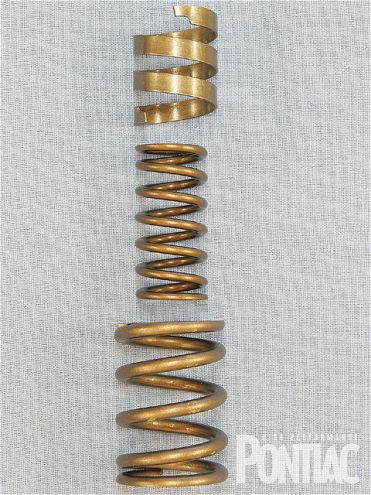 Most dual-valvespring packages include an inner and outer spring, as well as an internal damper. The damper is sandwiched between the two and uses the friction it creates to minimize spring surge.
Most dual-valvespring packages include an inner and outer spring, as well as an internal damper. The damper is sandwiched between the two and uses the friction it creates to minimize spring surge.
HPP: In what applications are (traditional-shaped) single-springs best suited?
TG: Generally speaking, a single cylindrical spring package is sufficient for low-rpm applications with mild camshafts and low valve lift. Modern single-coil beehive springs are a different story, however. They're designed for today's engines, which typically feature more valve lift and operate at higher speeds.
HPP: At what point do dual- or triple-springs become necessary?
TG: There are just too many variables to suggest a specific point when either spring package becomes necessary, but traditionally speaking, dual-cylindrical springs are required when using a camshaft with a high valve-acceleration rate or when running a heavy valvetrain at high engine speed. Triple-springs are used in applications where dual-springs can't sufficiently control the valve through the entire event.
A point to remember when dealing with valvesprings is that there are measurable losses associated with having "too much" spring. Overall spring weight, coupled with the resistance forces associated with dual- or triple-springs, results in higher inertial forces, and that can add load to the system. This load can cause valve-timing changes at low, mid, and high lift, and that can affect the overall curve of the valve event. The result is an airflow disruption that lessens horsepower and torque.
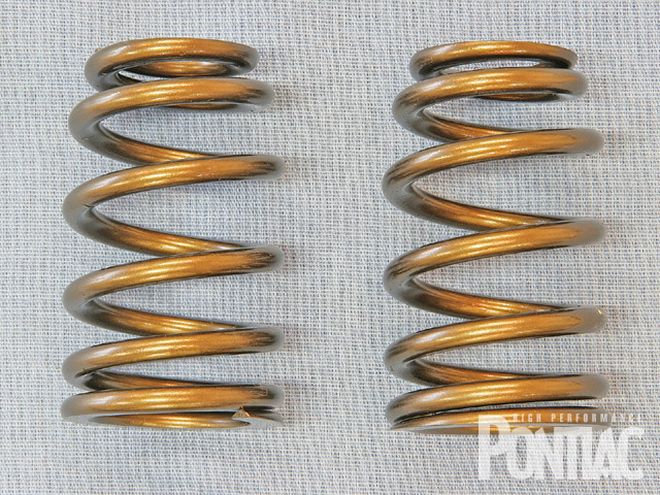 Conical-shaped springs start with a wide base and taper toward the top, while beehive springs, such as these from Comp Cams, are mostly cylindrical, tapering over the top two coils. The appearance and function of the two types is similar.
Conical-shaped springs start with a wide base and taper toward the top, while beehive springs, such as these from Comp Cams, are mostly cylindrical, tapering over the top two coils. The appearance and function of the two types is similar.
As dual-spring technology continues making great strides, we're able to use duals where triples were once necessary, and we're finding instances when a single beehive spring can be used in place of a dual-spring. If there's any question of which is best for a specific application, our technical-support staff and engine-build salesmen are prepared to assist customers with the proper selection.
HPP: You've mentioned "beehive" springs several times. I've also seen such springs referenced as "conical." Are there differences between the two, and can you explain the advantages over a cylindrical-shaped valvespring?
TG: A beehive spring is cylindrical for most of the body length and tapers over the top two coils. A conical spring tapers gradually over the entire length of the spring body. Both types drastically reduce the moving mass of the spring and allow the use of a smaller diameter retainer. That frees up the power losses associated with the friction generated from added valvetrain mass, increased spring loads, and component deflection.
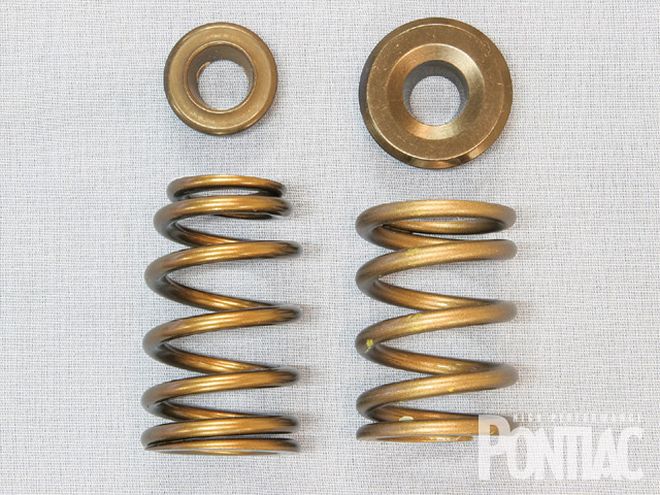 In addition to improved valve control and their tuning effect, modern beehive-type springs allow the use of a much smaller valvespring retainer. The unit on the right is used with a typical cylindrical spring, while the smaller unit at left is used with a beehive-type. The reduction in valvetrain mass allows for better valve control at high engine speed.
In addition to improved valve control and their tuning effect, modern beehive-type springs allow the use of a much smaller valvespring retainer. The unit on the right is used with a typical cylindrical spring, while the smaller unit at left is used with a beehive-type. The reduction in valvetrain mass allows for better valve control at high engine speed.
HPP: In what applications are beehive/ conical springs popular?
TG: Most of today's production vehicles are factory-equipped with beehive-type valvesprings constructed with ovate wire. The materials and manufacturing techniques we use at Comp Cams to produce our line of performance beehive springs is at a race level. They're quite popular in late-model performance builds but have a growing popularity in vintage applications, too.
It seems that those hobbyists with hydraulic rollers and some aggressive hydraulic- and solid flat-tappet camshafts are seeing horsepower gains and can rev their engines higher when using a lighter-load beehive in place of a heavier dual-spring package, but it all depends on the application and engine speed involved.
HPP: What is the thought process between install height, wire diameter, number of coils, and overall shape when designing valvesprings?
TG: Valvesprings incorporate certain load ranges at certain installed and open heights, with a specific amount of clearance between open height and coil bind. A critical consideration when designing a valvespring is the amount of vertical space the unit has to work within (spring height) and the certain harmonic frequency it resonates at during normal operation. We then construct it of the smallest wire and body diameters that will handle the stresses involved, while providing the desired natural frequency. The number of coils is a byproduct of this.
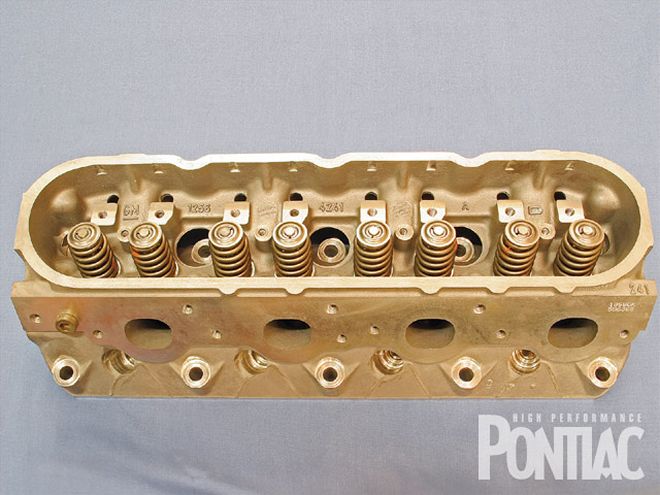 Late-model Pontiacs feature LS-type engines, which use cylinder heads that including single beehive-type valvesprings constructed of ovate wire. They have proven quite reliable when operated within their design limits.
Late-model Pontiacs feature LS-type engines, which use cylinder heads that including single beehive-type valvesprings constructed of ovate wire. They have proven quite reliable when operated within their design limits.
HPP: What is "natural frequency" and how does it relate to valvesprings?
TG: The natural frequency of any object is the harmonic frequency at which it cyclically vibrates when subjected to external input. There are two basic examples: free vibration and forced vibration.
An example of free vibration is a guitar string that's been plucked. It vibrates back and forth after the initial external force is removed for a certain number of times per second, and that number is its natural frequency, in Hertz (Hz). It continues until the vibration decays, the energy completely dissipates, and the string stops moving.
A car's wheel and tire that's out of balance is an example of forced vibration. The wheel and tire will vibrate up and down (somewhat violently), shaking the car. Because the car is constantly moving, the external force is making the wheel spin at its natural frequency.
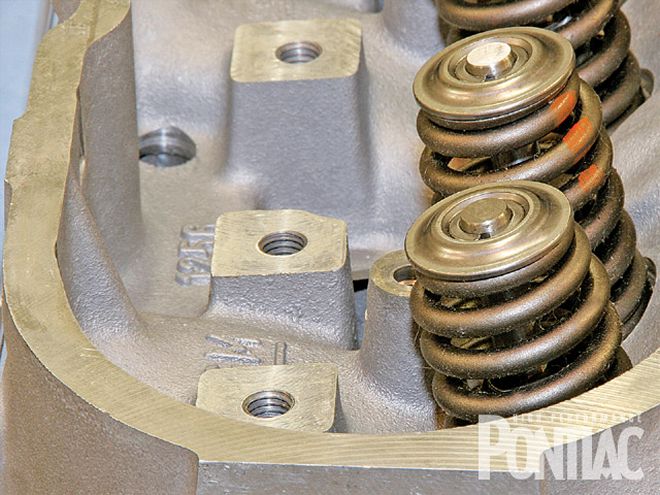
Valvesprings are exposed to both types of vibration during normal operation. As the valve opens and closes, the spring is subjected to forced vibration. The spring is then subjected to free vibration while the valve is closed and the lifter rides on the camshaft's base circle. This results in a harmonic frequency that's independent of engine speed. As engine speed climbs, cam-cycle duration gets increasingly shorter and the number of vibration cycles decreases, but the natural frequency remains the same.
HPP: How does natural frequency relate to "critical speed?"
TG: As the valvespring coils vibrate at the spring's natural frequency, the spring oscillates more vigorously at certain engine speeds. When that particular engine speed is reached, it's known as "critical speed," and several things happen simultaneously, which compromise valve control. The result is a lack of spring force to hold the valve closed at that speed, which can lead to a condition known as "valve bounce" or worse, broken valvetrain parts.
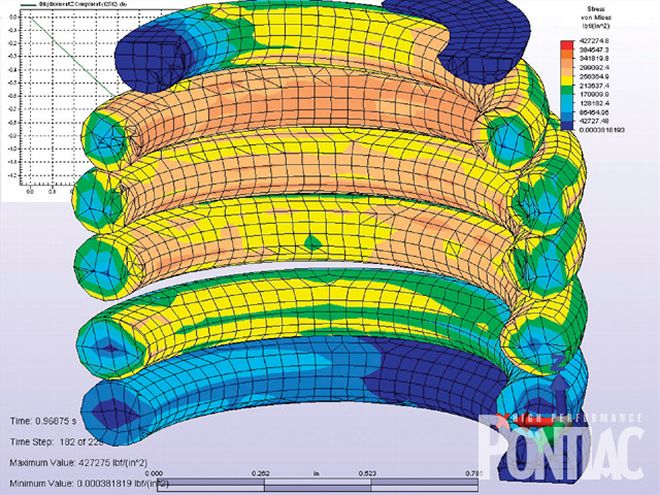 This diagram provided by Comp Cams depicts a cross-sectional view of a No. 26918 beehive spring that's loaded to near coil bind. This Finite Element Analysis (FEA) allows designers to look for the highest stress points of the design and adjust accordingly. Blue indicates low stress areas, while red indicates stressed areas that are too high for extended life of the material. Notice that the wire is ovate. Its shape is designed to combat the stress loads the spring carries.
This diagram provided by Comp Cams depicts a cross-sectional view of a No. 26918 beehive spring that's loaded to near coil bind. This Finite Element Analysis (FEA) allows designers to look for the highest stress points of the design and adjust accordingly. Blue indicates low stress areas, while red indicates stressed areas that are too high for extended life of the material. Notice that the wire is ovate. Its shape is designed to combat the stress loads the spring carries.
HPP: How can valve bounce be combatted?
TG: We can tune a valvespring by tweaking a few different aspects of its geometry or the material from which it's constructed to control valve bounce. This includes changing the spring's overall diameter, wire diameter, the number of active coils, or the space between the spring coils. We refer to this as "pitch layout," and it will affect either the spring's stiffness or mass, or both.
While there are no steadfast rules when tuning a spring, we often try to design a spring with a higher natural frequency, if possible. It isn't as easy as changing numbers, however. The dilemma that's presented to the spring designer is juggling the stresses around desired loads or frequencies while constrained to a limited space.
Beehive springs have damping coils designed into them. This consists of a couple of tightly wound coils at the bottom of the spring, and because these coils are spaced more closely, the resonance (or surge) wave bounces among them. Much of the resonance energy is trapped in this "sink" area and dissipates before it can rebound back up the spring.
HPP: Does this relate to the damper found in some cylindrical spring packages?
TG: Yes. As the valve opens very fast at high engine speed, a surge wave is generated by the motion that travels down the valvespring. The damper uses the friction that exists between it and a cylindrical valvespring to "damp" or minimize spring surge, which can cause any number of issues, including those mentioned before, but some cylindrical dual- and triple-springs don't require dampers. Instead, they use their interference fit to perform the same task, while beehive springs contain damping coils.
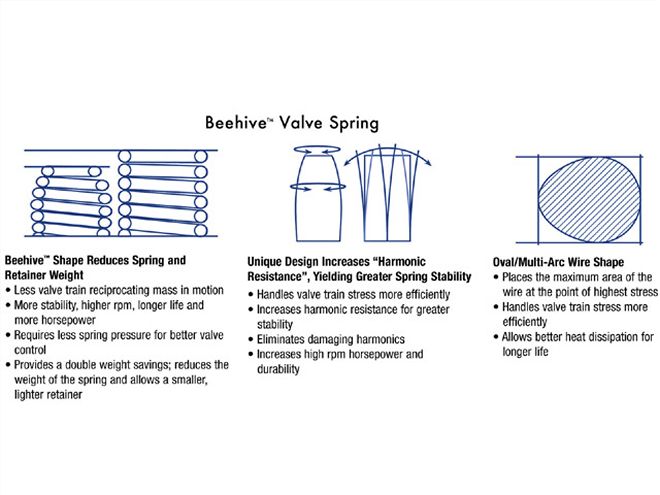 Taken from the Comp Cams catalog, this diagram extols the various advantages of beehive valvesprings and ovate wire.
Taken from the Comp Cams catalog, this diagram extols the various advantages of beehive valvesprings and ovate wire.
HPP: How does the overall valvetrain weight affect performance/rpm?
TG: Weight on the valve side of the valvetrain should include the lock, retainer, valve, and valvespring. In most cases, a lighter valvetrain allows for increased valve control at higher engine speed, and it also reduces overall valvetrain mass, which can let the engine spin higher. Pontiac engines tend to have a heavy valvetrain, and that can limit maximum rpm. One way Pontiac engine builders can increase that speed is to use a valve with a smaller stem and thinner head, significantly lightening it. The next constraint would then be the amount of lift available.
HPP: How are valvesprings cooled?
TG: When a spring is compressed, the metal's grain boundaries move around, causing friction inside the metal itself. This friction results in an enormous amount of heat generated during normal operation; engine oil is then used to cool the springs. If they're not cooled properly, their effectiveness diminishes, and in some applications, can actually break.
HPP: Does fatigue occur and is it predictable?
TG: By definition, fatigue is the reduction of a spring's effectiveness over time, and it's a function of material manufacturing techniques and application. It occurs in one or both of two ways-first, with load loss, and second, with complete failure. Predictability is next to impossible because of these factors.
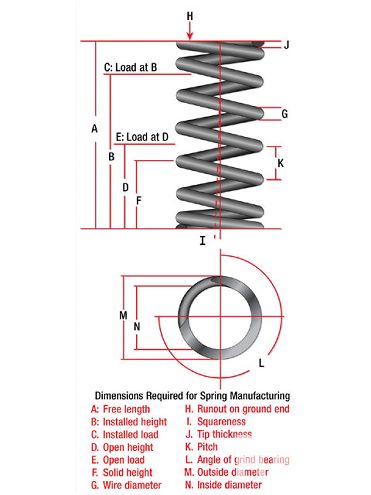 Many hobbyists are familiar with some of the terminology associated with an engine's valvesprings, but that's only a portion of what valvetrain engineers must consider when designing them for specific applications. This diagram reveals some others.
Many hobbyists are familiar with some of the terminology associated with an engine's valvesprings, but that's only a portion of what valvetrain engineers must consider when designing them for specific applications. This diagram reveals some others.
HPP: Which Comp Cams valvesprings are commonly suggested for Pontiac applications?
TG: Our engine-builder salesmen tell me that our beehive Nos. 26986 and 26125 are popular choices for many street-driven Pontiacs that utilize either type of flat-tappet camshaft or a hydraulic roller. No. 978 is a cylindrical dual-spring set that's popular in engines that see higher speeds. We suggest calling our technical support staff to discuss specific applications, however.
HPP: What do you see in the future?
TG: As hobbyists learn more about beehive-type valvesprings and realize that such technology is here to stay, they are becoming more comfortable with the idea of running a single beehive spring in performance applications where only a cylindrical dual-spring was once suitable. As beehive technology grows and these springs are utilized in more applications, we continue to see its abilities and limitations and can suggest applications where they might not be suitable.
In addition to valvesprings, we've developed a line of new tool-steel retainers for both our beehive springs and traditional cylindrical units. These retainers are much lighter and stronger than our typical steel units. In fact, we're suggesting them in applications where titanium retainers were once the only choice. While titanium units are still a necessity in extreme applications, the tool-steel units are much stronger and weigh only 2-3 grams more for a fraction of the cost.
Conclusion
Comp Cams is just one company familiar with modern valvespring technology, and there's little doubt that the engineers of competitors are focusing on ways to improve components in the same manner.
No matter the case, valvespring technology is rapidly changing, and the comments Griffin shared point us toward the future. So the next time you remove your Pontiac's valve covers, take a moment to look at its valvesprings and think about the stressful conditions in which they operate. You might have a newfound respect not only for those components, but the people who design them.